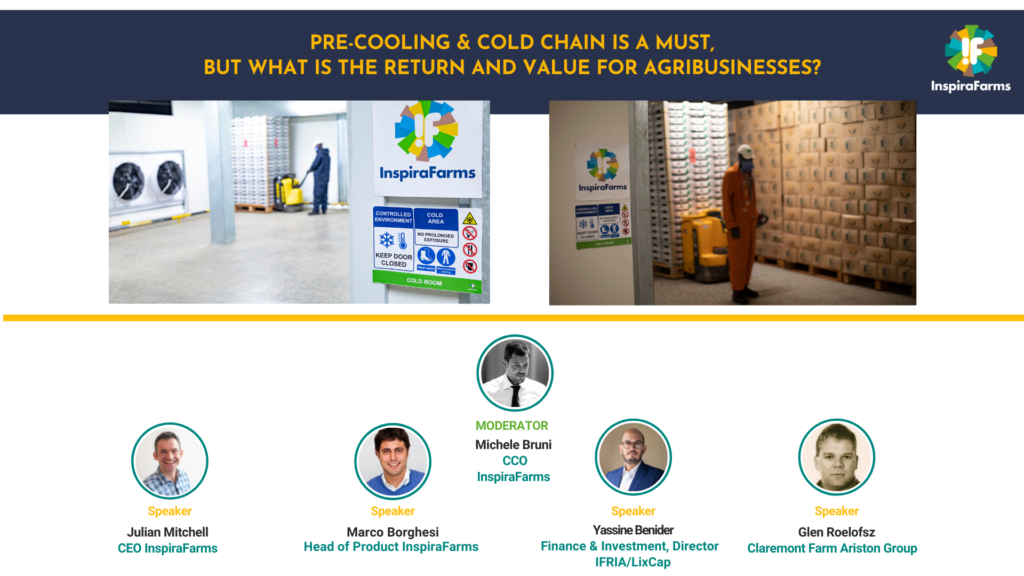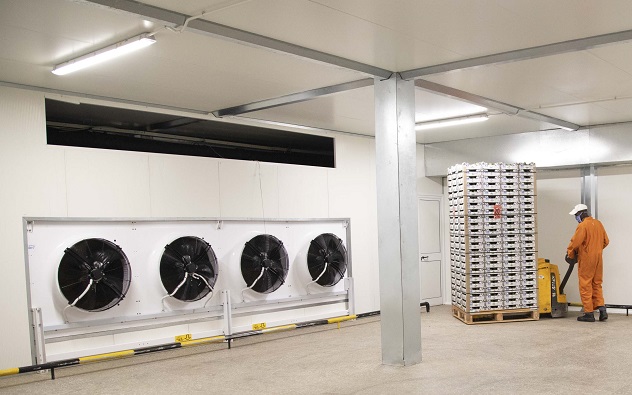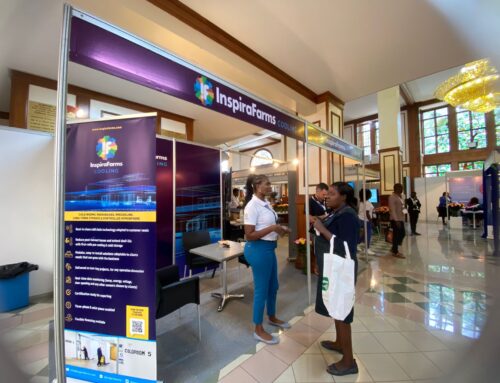Key take-outs of the webinar: Pre-cooling & cold chain is a must, but what’s the ROI?
Once again, our webinar on “Pre-cooling & cold chain is a must, but what’s the Return on investment (ROI)” brought together experts from different fields in the cold chain sector such as Glen Roelofsz from Claremont Farm/Ariston Group Zimbabwe, InspiraFarms Chief Executive Officer (CEO) Julian Mitchell and Project Manager Marco Borghesi, Finance & Investment Director of IFRIA/LixCap Yassine Benider moderated by Chief Commercial Officer (CCO), Michele Bruni.

We look at the key points brought out in the webinar from the discussion with the speakers around the topic, with a focus lifetime value of on-farm pre-cooling and first-mile cold-chain.
The importance of cold chain
Starting us off, Glen opened the webinar by stating that the mantra of all post-harvest technology is that it is all about temperature. Without a cold chain system, any fresh produce business, be it for a local or an export market, depending on the production zone can incur problems in sustainability and viability.
The focus on cold chain and technology has been by the market to increase quality demands, expectations and sophistication of the consumer and competition.
Pre-cooling and cold chain will allow management of the supply and off-take of your product, extend its shelf-life, manage its ripening processes and its storage potential. This will also allow you to manage the feeding of the market through over supply periods as best as possible.
Additionally, the world volume has increased and the cost implications of air freight are becoming ever more present, particularly in the last 18 months due to COVID. Prior to that, for most products to be viable and competitive in the international marketplace, we are seeing a switch to sea freight, that has a much longer transit window from the point of production to international shelves. Therefore, one must be that much more efficient with their cold chain.
“The lack of efficiency or lack of effectiveness in a cold chain is not necessarily exposed in a 48-, 72- or 96-hour air freight transit but at the sea freight conditions, which can be anywhere between two and four weeks internationally. If your cold chain is not up to standard, your product will be compromised,” said Glen.
With increasing competition, there is less margin for error in the horticultural production, packing, grading, and exporting supply chain. Without a quality product that has been through a cold chain, the impact on viability and finance is immense.
How to maximize/generate returns with pre-cooling and cold chain
According to Julian, the most fundamental element to think about as an agribusiness is that your solution gives value to your customer.
He brought to light the 4 key elements from InspiraFarm’s formula that have helped in generating returns with pre-cooling and cold chain which are: reducing losses, increasing shelf life, decreasing OPEX and giving customers access to data.
The lower your losses, the more produce you sell generating more income for you and therefore creating more value. However, what is more complex is how to do that. A loss rate of 15% can reduce to up to a loss rate of 10% with the help of pre-cooling and cold chain facilities as given in the below example.
“Moving from 15% to 10% may not seem like that big of a difference however, when you start to run the return-on-investment calculations, and you start to compound what those additional 1% gains on your loss rates equate to, you start to realize how much you could be gaining. If you are selling 10 kgs of produce, and you are getting about $5000 back on farm for that you are going to get about $50,000 a month for that produce. If you have a 15% loss rate that represents about a loss of $7500. If you could drop it down to that 12%, that is an additional $1500. And with 10%, that is an additional $1000. When you start to compound that to a season of six months, that would turn into $15,000,” Julian explained.
Once you tackle issues of loss with the help of pre-cooling and cold chain systems, comes the increase in shelf life. It is critical to get the cooling rate right at the very beginning of the process because it can then impact the end process when it arrives on the customer’s shelves. Ensure that the pre-cooling and cold chain systems are of good standard
This will also give you the option to move from air to sea freight. A worthwhile investment will give you confidence that your produce will arrive in excellent quality while reducing costs and lowering your costs of OPEX.
The ROI in Investing in Cold chain for fresh produce
IFRIA who have been assisting different investors access opportunities in emerging markets, are now the first to establish the largest platform of cold chain projects over Africa. Their current investment focus is establishing large cold hubs of about 5000 pilot positions or above that service export volumes, import volumes and local production volumes and have recently started investing in near farm infrastructures.
“We are aware that there is an important gap for such infrastructure that needs to be covered. We have identified constraints to access finance for local large farmers and players,” said Yassine.
For this reason, IFRIA offers cold chain as a service by making the investment themselves while raising both equity and depth required to cover such investments.
“We believe that facilitating the access to such facilities to local farmers, wholesalers or cooperative farmers will enable them to reduce their post-harvest losses, improve their quality and access new markets. All this while increasing their revenues and appreciate their margins after paying the storage fees,” he added.
IFRIA’s added value in providing cold chain as a service is not only to raise funds, but also their expertise on management of the facilities such as the operating cycle and how to optimize it, as well establishing a financial scheme to put in place.
With the high level of fixed costs that comes with cold chain systems such as electricity consumption and land rent, IFRIA makes sure that solar panels are included in their investments enabling them to cover 70% to 80% of the extra consumption. By doing so, they do increase their CapEx however making some economies on their OPEX and improving their Return on Investment.
“Our aim is to propose the most competitive price and for us to do so, we have to make sure we control and make our costs as low as possible,” he concluded.
The Impact of Data in generating ROI for pre-cooling and cold chain
During packing your produce and by the time it gets to the point of arrival, up to 40% of produce is lost due to molding and rusting that occurs after shipment. Thanks to data, this can be reduced to 0% like in client cases brought out by Marco Borghesi during the webinar. The key issues that data helps tackle are reducing losses by reducing interruption on machinery operations and reducing rejection from importers to increase shelf-life.
Marco suggested that to increase shelf-life, the fastest and easiest toolset to use on data is to simplify digital auditing.
“The InspiraFarms portal enables clients to download data and produce reports so that audits are reduced. It becomes much easier to demonstrate the quality of the cooling process to the importer and therefore make those dollars count at import,” he said.
To manage different crops and increase the top line, Marco stated that InspiraFarms is now substituting old manual systems that require onsite operations to change cooling cycles when changing crops, to a digital system that is fully automated and that will be completely manageable remotely in the future.
“We are automating alarms for clients, so that we are not the only ones reducing intervention times and reducing losses, but also everyone operating the specific facility to make it that easy and as quick as possible. We are also adding safety features to reduce downtime of operations through remote control. We are working on automated and aggregated crop profiles, cooling profiles as we continue to learn from the data. The more systems we do, the more we see what works best and what does not so that we can introduce learnings from the past into our algorithms for the best cooling features. With the implementation of solar options, we have sensors for energy to assist with reduce of price,” he concluded.
Conclusion
The webinar overall shared positive results on ROI when adopting appropriate postharvest technologies, especially around precooling and that indeed, there is lifetime value of on-farm pre-cooling and first-mile cold-chain. It was established that to invest in the most adequate and cost-effective cold chain elements, the farmer, aggregator, or trader must be confident that the operation and market will reward the investment.
Stay up-to-date by signing up to our newsletter here and look out for our next webinar



